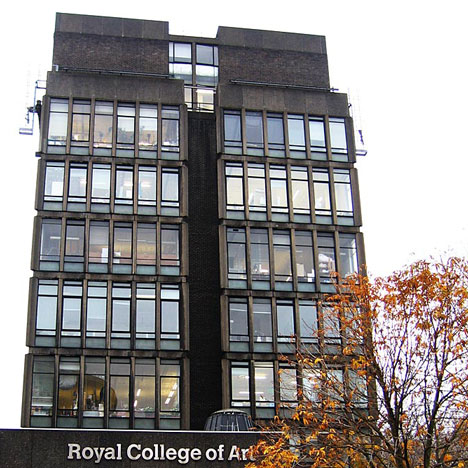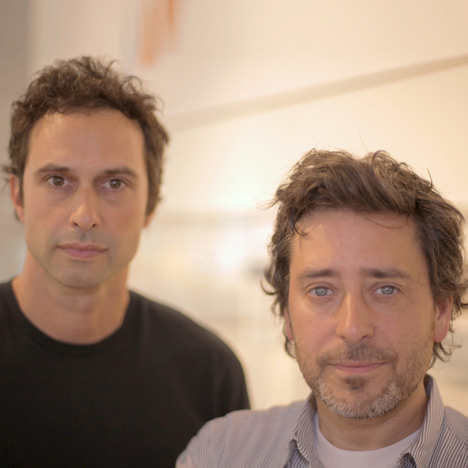"UK government doesn't value the role of creativity" say Barber and Osgerby
London's position as a leading creative city is under threat thanks to rent rises, arts education funding cuts and a government that is "scared by creativity," according to this year's London Design Medal winners Edward Barber and Jay Osgerby.
The duo behind design studio Barber & Osgerby said the city is reaching a "tipping point" that could lead to the demise of its world-famous creative scene.
"It's starting to feel different," said Osgerby during an interview with Dezeen at the duo's Shoreditch studio last week.
"It's becoming more and more expensive," added Barber. "I have a horrible feeling that's going to have a detrimental effect in the near future on more young creatives."

Barber and Osgerby also warned that cuts to UK art school funding, particularly the foundation courses, will add to this decline.
"Our government doesn't really value the role of creativity in our economy," said Osgerby. "The government seems to think that creativity is just something that is here and it'll just happen, but without the ability to educate and nurture it will disappear."
"They are scared by creativity because they don't understand it," added Osgerby. "They're cutting and they're closing foundation courses, which are probably the most important courses in the country. It's totally short sighted."
Barber added: "The foundation course is absolutely critical because it teaches you how to draw and how to look at things properly, but it also give you that opportunity to really find your sort of area before you then get into a degree course."

The duo studied at London's Royal College of Art, which was this year named as the world's top design school, but has recently been rocked by a series of senior staff departures.
"They're not getting any money so they have to expand the courses, which puts so much strain on everyone," said Osgerby.
Leading figures have previously expressed concern over changes to immigration rules that could threaten London's status as a centre for the global design and architecture industries.
Earlier this year, British inventor James Dyson attacked fresh government plans to force foreign students to return home after completing their studies.
"Our education system should be a tool to import the world's greatest minds," said Dyson. "And, most importantly, to keep them here, so our economy – and our culture – benefits."

Their comments follow a caution from Rohan Silva, a former advisor to UK prime minister David Cameron, who warned London could go the same way as New York – which is seeing its creatives move to cheaper spaces in Los Angeles.
Read an edited version of our interview with Barber and Osgerby below:
Dan Howarth: Do you think London still has its creative gravitas?
Ed Barber: London, I personally believe, is absolutely the creative centre of the world at the moment and I think it has been for a number of years, and I think it's getting more and more intense in a way. So many people are moving to London.
But I have a fear that there are so many people coming to London, it's becoming more and more expensive – mainly more from a sort of property point of view, living and renting studios – and I have a horrible feeling that's going to have a detrimental effect in the near future on more young creatives. When we set up, rent was always a bit expensive but it was manageable. But I mean now, I don't even know how.
Jay Osgerby: It's having an effect on lots of sectors too.
Ed Barber: You get pushed out further and further and further until a point where you feel like you're not really in London, and then you think well let's go to Berlin or let's go to Paris or wherever. Somewhere that you can get a studio in the centre that's much more reasonably priced and that is a concern, I think, for London generally for the younger creatives.
It's all very well having the established people in there but if you haven't got the sort of effervescence of the young talent in there as well it all becomes a bit dry I think and I mean at the moment that isn't, well it is a problem, but it hasn't changed London yet.
Jay Osgerby: It's becoming an increasing issue, but you're quite right it's starting to feel different.
Dan Howarth: Is London at a tipping point?
Ed Barber: I think probably yeah.
Jay Osgerby: I think so. There are only so many areas of London that can become regenerated by creatives trying to find somewhere they can afford to live but still get to work. I can't imagine they can go much further out before people think it's not really worth it for them anymore.
On the other hand, I wonder whether this could have been an ongoing feeling for many, many, many years or centuries even. London has always been this sort of hub of the world, where Europe meets America.
Ed Barber: I don't think any city stays at the top of the pile forever. The real big ones, New York and London, are always at the top but I think each city has their moment, doesn't it?
One minute its Paris, the next its Milan and then it's Rio for a period of time, but London's managed to stretch this out for quite a number of years and there's a lot of factors that led to that.
Jay Osgerby: It's a great place for us to work still, providing everyone can afford to live somewhere and we can afford to have a studio here. It works well because physically the connections to Europe are perfect for us, and to the States. It makes business easy.
Dan Howarth: Do you think the London's arts schools are still as good as they were 10, 20 years ago?
Jay Osgerby: It's very easy for old gits to always think that things were better back in the day and so you have to be really wary of that. I think the sheer numbers of people who are going through our school system now must put a strain on it. But the thing is if you are a creative person, you'll get through that and you'll find your way.
Ed Barber: When we were studying at the Royal College of Art, it was going through a really tricky time on our course. We didn't even have a professor for the second year so the whole thing went into a bit of a spin.
So it's up to you to really take from whatever that college can offer. We went into all sorts of departments. Jay spent a bit of time with furniture. I spent loads of time at photography and graphics. We just made the most of the place, really.
Jay Osgerby: And we were working on our own projects by then as well
Ed Barber: Once you get to MA level, you're not sitting there being taught every day anyway. We were regularly down at the V&A museum looking at stuff too. That's another thing London can offer so much of in terms of being educated here – all the other cultural institutions that you can use. Even if you've got an amazing design school, but it's tucked away in the countryside in somewhere, the school might be great, but you don't have all that access. So, London colleges are supported by the exterior inputs.
Dan Howarth: There's been some turmoil at the Royal College of Art recently. Lots of staff have left and I've heard that some of the students are unhappy.
Jay Osgerby: The change is precipitated by the fact that they're not getting any money so they have to expand the courses, which puts so much strain on everyone.
It's completely wrong. Because I think our government doesn't really value the role of creativity in our economy to its full extent. I firmly don't believe that the market should educate as well as everything else. They're lacking funding, they're cutting and they're closing foundation courses, which are probably the most important course in the country. It's totally short sighted.
Ed Barber: The foundation course is absolutely critical because it teaches you how to draw and how to look at things properly, but it also give you that opportunity to really find your sort of area before you then get into a degree course.
Otherwise, you just launch yourself into something you don't really know anything about and you know of course there are going to be a high percentage of people that suddenly think well I shouldn't, this isn't really quite what I wanted to do.
Dan Howarth: So the government is cutting the funding for these courses?
Jay Osgerby: To me, the government seems to think that creativity is just something that is here and it'll just happen, but without the ability to educate and nurture it will disappear. [The UK's] creative reputation, which the government likes to talk about and celebrate, is the consequence of art school education from the late 1950s and those people like us who benefitted from it, we're not going to be around forever.
You need to nurture creativity just like you do sciences and maths but there's a real tendency for people to not understand. They're scared by creativity because they don't understand it. Its not empirical, we're not going to create something that can be directly exported because we're not mechanical engineers. It's intangible but it has a huge value.
Ed Barber: Also if you take specifically furniture we certainly believe you can't really design successfully furniture if you can't physically make models. A lot of the colleges have done away with a lot of the workshops because they take up a lot of space and need staff, and they falsely think that you don't need a workshop now because you've got a computer. But you're still looking at a flat screen, you're not interacting with something physical.
I just feel that when we speak to people and we go to college shows, everyone is so worried about the final image and the slick presentation, but all that rough work in the middle is much more important to actually understand have you got the right bones of the project, and does it really work?
Something like a piece of furniture you actually live with everyday, it's not like a piece of graphics that you open a magazine and go "wow" or "no" and then you close it and you go away. Something like a chair you use for 20 years of your life or more, it has a quality to it that you have to interact with and I don't think you can do that by designing on a screen. You have to have a physical presence.